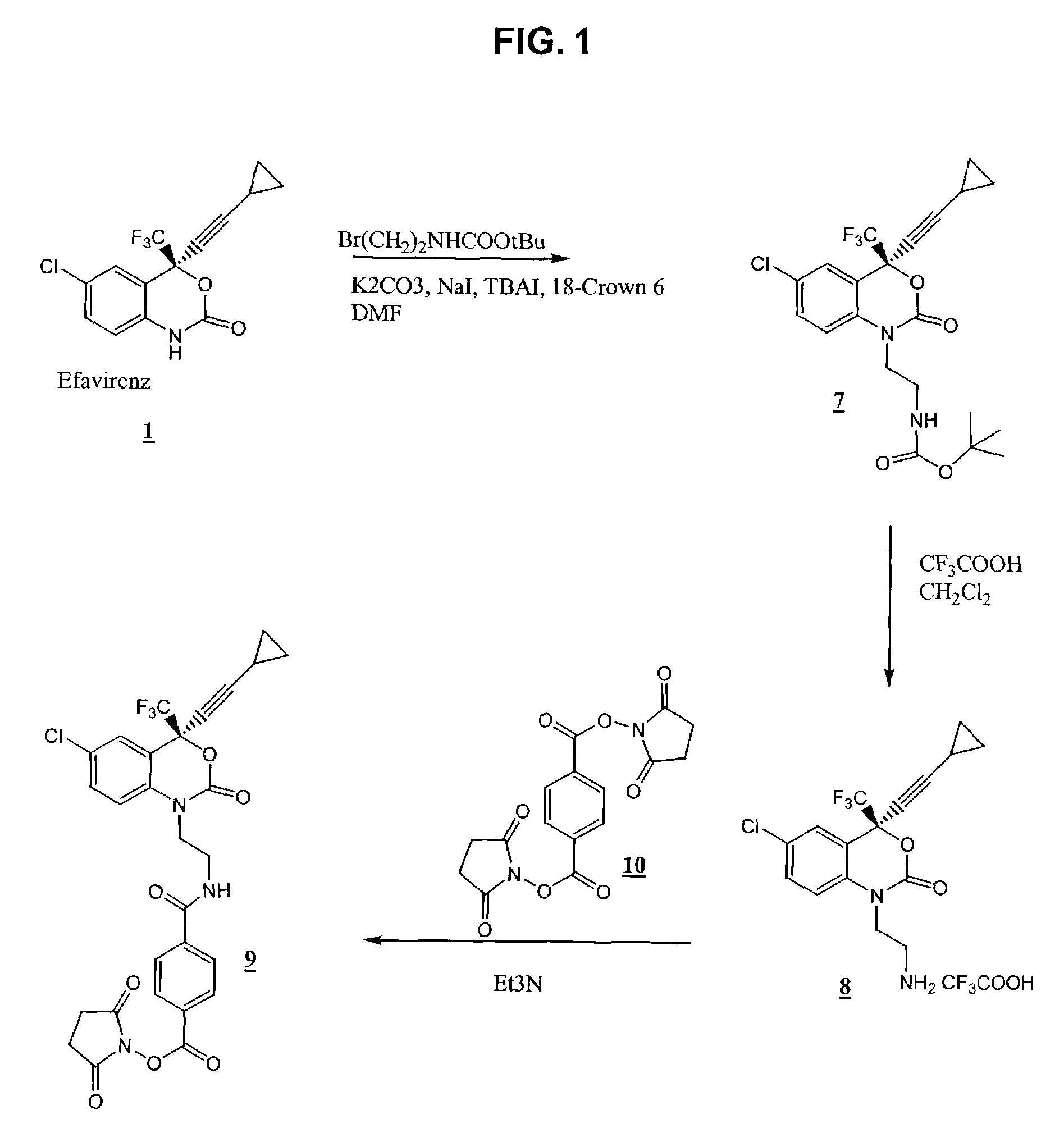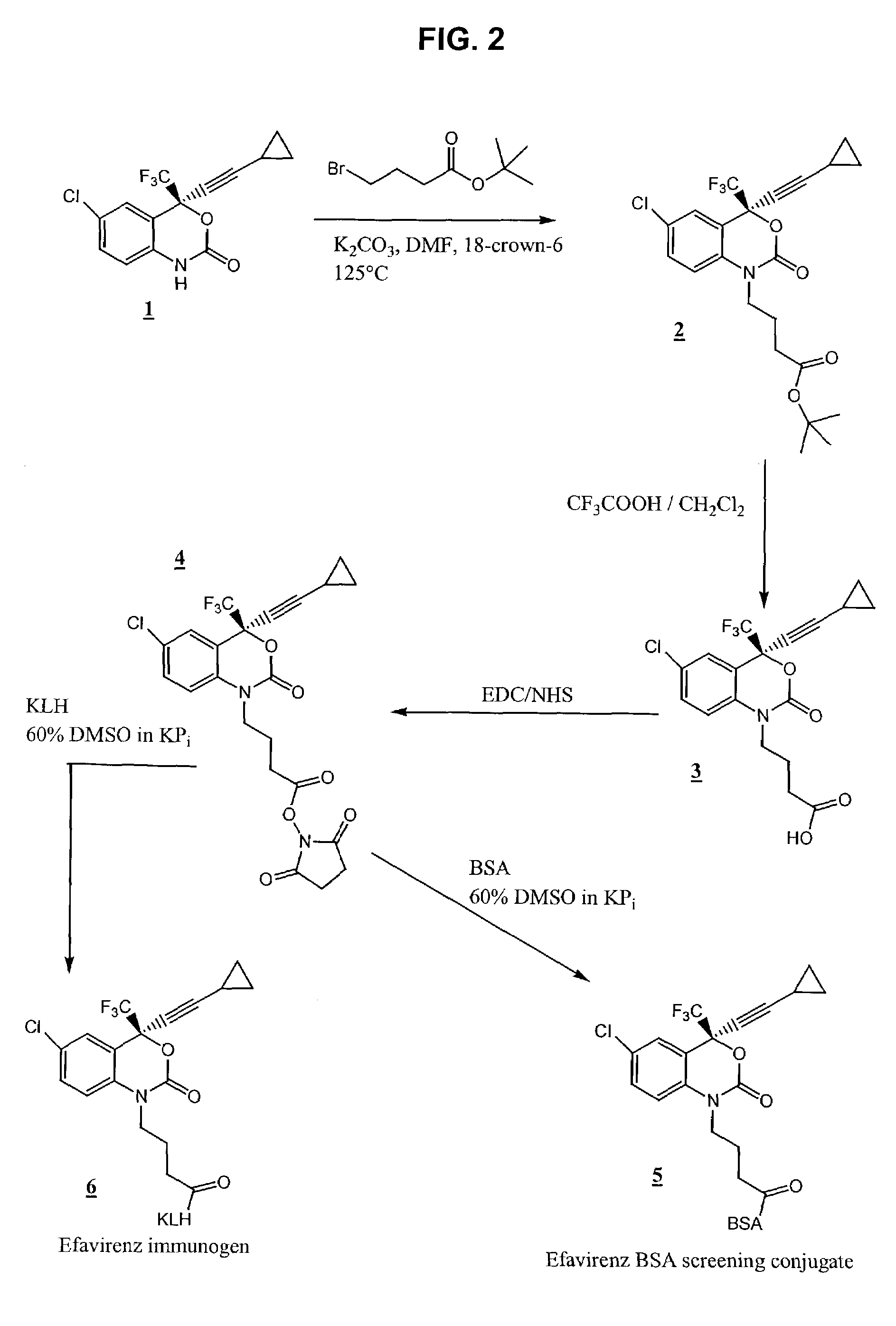Reagents for detecting efavirenz
a technology of efavirenz and reagents, which is applied in the field of immunogens comprising efavirenz, can solve the problems of low and high efavirenz plasma levels, impractical commercial use methods, and associated treatment failures and cns side effects
- Summary
- Abstract
- Description
- Claims
- Application Information
AI Technical Summary
Benefits of technology
Problems solved by technology
Method used
Image
Examples
example 1
Synthesis of 4-(6-chloro-4-cyclopropylethynyl-2-oxo-4-trifluoromethyl-4H-benzo[d][1,3]oxazin-1-yl)-butyric acid tert-butyl ester (2)
[0055]To 250 mg (0.79 mmol) of efavirenz 1 was added 10 mL of anhydrous DMF, 600 mg (4.34 mmol) of potassium carbonate, 120 mg (0.80 mmol) of sodium iodide and 492 mg (2.2 mmol) of 4-bromo-butyric acid tert-butyl ester followed by 5 mg of 18-crown-6. The mixture was heated to 125° C. for 2 hours under argon atmosphere and concentrated under reduced pressure. To the residue 50 mL of chloroform was added, and the solid was filtered off. To the filtrate 50 mL of water was added. The organic layer was separated, washed with 50 mL of water, dried (Na2SO4), and concentrated. The residue was purified by silica gel flash column chromatography in 70% ethyl acetate in hexane to give 327 mg (0.721 mmol, 90% yield) of 2 (M+Na, 480).
example 2
Synthesis of 4-(6-chloro-4-cyclopropylethynyl-2-oxo-4-trifluoromethyl-4H-benzo[d][1,3]oxazin-1-yl)-butyric acid (3)
[0056]To 290 mg (0.63 mmol) of 2 was added 6 mL of dichloromethane and 6 mL of trifluoroacetic acid. The reaction mixture was allowed to stir at room temperature for 30 minutes and concentrated under reduced pressure. To the residue was added 40 mL of dichloromethane, which was subsequently concentrated under reduced pressure. The above process of addition of dichloromethane and concentrating under reduced pressure was repeated four more times to give 240 mg (0.59 mmol, 94% yield) of 3 as a thick gum (M+H, 402).
example 3
Synthesis of 4-(6-chloro-4-cyclopropylethynyl-2-oxo-4-trifluoromethyl-4H-benzo[d][1.3]oxazin-1-yl)-butyric acid N-hydroxysuccinimide ester (4)
[0057]To a solution of 200 mg (0.49 mmol) of 3 in 30 mL of dichloromethane (distilled over CaH2) was added 225 mg (1.2 mmol) of 1-ethyl-3-(3-dimethylaminopropyl)-carbodiimide (EDC) and 102 mg (0.88 mmol) of N-hydroxysuccinimide (NHS). The reaction mixture was allowed to stir at room temperature 18 hours under an argon atmosphere. To this reaction mixture was added 40 mL of dichloromethane, and the organic layer was washed with 2×50 mL of water and 2×50 mL of saturated sodium bicarbonate followed by 75 mL of water. The organic layer was dried (Na2SO4) and concentrated to give the crude activated ester. This was purified by silica gel chromatography using 50% ethyl acetate in hexane to give 98 mg (0.19 mmol, 39% yield) of 4 as white powder (M+H, 499).
PUM
| Property | Measurement | Unit |
|---|---|---|
| size | aaaaa | aaaaa |
| diameter | aaaaa | aaaaa |
| diameter | aaaaa | aaaaa |
Abstract
Description
Claims
Application Information
 Login to View More
Login to View More - R&D
- Intellectual Property
- Life Sciences
- Materials
- Tech Scout
- Unparalleled Data Quality
- Higher Quality Content
- 60% Fewer Hallucinations
Browse by: Latest US Patents, China's latest patents, Technical Efficacy Thesaurus, Application Domain, Technology Topic, Popular Technical Reports.
© 2025 PatSnap. All rights reserved.Legal|Privacy policy|Modern Slavery Act Transparency Statement|Sitemap|About US| Contact US: help@patsnap.com



